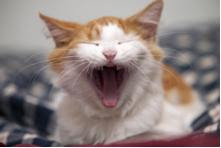Wide asleep – this was a phrase I came across recently when I attended a knife awareness seminar. It was referring to that situation that many people are in day to day when they are awake and walking around, getting on with their business but are completely oblivious to their surroundings.
You know – people walking around with iPods plugged into their ears, chatting idly on their mobile phones or just lost deep in their own thoughts taking absolutely no notice of their surroundings; leaving themselves a sitting duck for any would be opportunist attacker.
This state of being wide asleep is part of Cooper’s Colour Codes, a simple tool that can aid us in understanding various stages of awareness and alertness and provide a strategy for dealing with any threats we may come across during our day. There are four levels of codes from white through to yellow, orange and red. There is a lot written about the use of this colour code system in self-defence which you can read about here or here, so I’m not going to describe it in any detail.
The other thing that struck me on this knife awareness course was that the techniques we learnt to escape from or disarm a knife attacker were very much based on some of the karate and kobudo techniques that I have learnt in my traditional martial arts classes; they had a familiarity to them.
People often criticise traditional karate for not being realistic or being too stylised or even worse – not teaching any self-defence at all! Having trained in karate for a few years now I don’t believe that the art is intrinsically unrealistic in approach but how useful it is does depend on how it is being taught.
There can be a gap between the way defensive moves are learnt in karate training and the self-defence moves in reality based training but I believe that this gap shouldn’t exist – that it can be bridged with thoughtful and intelligent training. I don’t like it when people say, “this is the art of karate but in real self-defence we do it this way,” as if they are completely different things. To me they are flip sides of the same coin – not different coins.
There can be a gap between the way defensive moves are learnt in karate training and the self-defence moves in reality based training but I believe that this gap shouldn’t exist – that it can be bridged with thoughtful and intelligent training. I don’t like it when people say, “this is the art of karate but in real self-defence we do it this way,” as if they are completely different things. To me they are flip sides of the same coin – not different coins.
It seems to me that both students and sometimes instructors can be operating at different levels of the Cooper Colour Code awareness system in the way they train/teach:
Code White: Awareness switched off (wide asleep). The student and possibly the instructor are completely oblivious as to whether what they are learning/teaching has any relevance to realistic self-defence. They are completely unaware as to how the components of their training (kata, kihon, kumite) actually fit together in a cohesive structure.
Code Yellow: Awareness is switched on. The student/instructor is aware that they need to make connections between the various elements of their training and look at its application to real life self-defence scenarios. However, despite this awareness they remain in a fairly relaxed state about it, unsure how to take the training to this new level.
Code Orange: In a state of ‘specific alert’, aware of the threat. The student/instructor knows how to pull the traditional elements of the system together and apply them to specific situations. He/she is knowledgeable about how violence operates in common attack scenarios including an understanding of escalation/de-escalation, triggers etc. They are aware of the common ways in which men and women are attacked and are able to teach self-defence techniques that relate directly to the techniques taught through kata, ippon kumite etc –i.e they are able to bridge the gap between traditional training and realistic self-defence. They can teach students how to make decisions on what action to take in specific scenarios.
Code Red: Ready to fight and carry out a plan of action. Students/instructor are prepared to be pressure tested in more realistic situations. The instructor is clearly able to articulate to and teach the student how hours spent in traditional kihon and kata training can lead to a level of mental and physical preparedness that coupled with an full understanding of the nature of violence and common attack situations and realistic defence training enables the student to develop full competence in all areas of self-defence.
I’d like to reach the state of code red in my training; I don’t think I’m there yet, I think I’m somewhere between yellow and orange – but I’m working on it. My awareness of the strengths and weaknesses of my training is very apparent to me and I’m working on how to fill the gaps.
If this knife awareness course taught me something it’s this: reality based self-defence is very much based on and dependent upon traditional martial arts. All of us on the course (all karate-ka) picked up the techniques quickly because we already knew how to move our bodies effectively to evade, block, unbalance and apply locks. The reality vs traditional gap is not so big after all – we just need to be sure that when we train we are not wide asleep…
Sue is the Blog-Editor-In-Chief for Martial News. You can contact her at sue.wharton@martialnews.co.uk
Sue also writes a personal blog called My Journey to Black Belt


2 comments:
Let me make a guess, you love "cats." :-)
Hi Charles, actually I'm not a great cat lover (I prefer dogs) but I thought these pictures were great!
Post a Comment